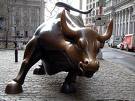Cioffi & Tannin: Future Household Names, if Anyone Still Owns a House in the Future
The Bankers Who Broke the World, Part 1
A Geek Tragedy
Told in Two Parts
The Players
Chances are that the names Matthew Tannin and Ralph Cioffi don’t mean a thing to you. They’re not the stars of an upcoming holiday movie. They didn’t lose in the Men’s Doubles Finals at the U.S. Open. And they weren’t the first team to pilot the Space Shuttle. Nothing like that. You’ll hear about them soon though, we all will.
You see, Mr. Tannin and Mr. Cioffi are two of the ultra-smart professionals whose work at Bear Stearns ended up starting the worst global financial meltdown the world has ever seen. Not bad for two kids from New Rochelle. Actually I have no idea where they’re from, but it’s got to be somewhere like New Rochelle, so what difference does it make?
Matthew Tannin and Ralph Cioffi worked at Bear Stearns Asset Management, a Wall Street firm that made its money advising others on their investments, and as of June 30, 2007, had $45.6 billion in assets under management. The two managed the Bear Stearns High Grade Structured Credit Strategies Enhanced Master Fund Ltd. (the “Enhanced Fund”), and the Bear Stearns High Grade Structured Credit Strategies Master Fund Ltd. (the “High Grade Fund”), which were hedge funds, registered as a Cayman Islands corporation with its principal place of business in New York, New York.
Bear Stearns Securities Corporation, located in Brooklyn, New York, served as the Fund’s prime broker, and acted as custodian for the Fund’s assets.
Ralph Cioffi was the founder and senior portfolio manager of the High Grade Fund and the Enhanced Fund from the inception of the fund in October of 2003 through July of 2007. At his side from day one and right up to the end, was Matthew Tannin, the portfolio manager for both funds. Sounds like they must have been good friends.
A Few Definitions…
Before we begin our story, it’s important that you know a few key terms.
NAV – A hedge fund’s Net Asset Value (“NAV”) is the value of the fund’s assets minus its liabilities. Sometimes you see it expressed as the total net value for the whole fund and sometimes as the net value for each share.
REPOs – A “Repo,” as those in the biz liked to call it, would more accurately be described as a “Repurchase Agreement.” A Repo is a type of loan agreement. Repos were used by hedge funds to increase the fund’s buying power. It was called a “Repo” because of how it worked. A lender would purchase securities from a borrower for less than the securities were worth. At some agreed to date, that lender would sell them back to the borrower at an agreed to price. Of course, since the securities were the collateral for the loan, if their value dropped, there could be margin calls against the borrower, meaning that the borrower would have to come up with the cash to cover the drop in value.
CDO – A Collateralized Debt Obligation (“CDO”) is a security backed by a pool of mortgages. The mortgages generate interest, which is paid out to the investors in the CDO. Typically a CDO is divided into parts called tranches, and an investor in a CDO could own part of a tranche, or all of the tranche. The top tranche was considered to be the most secure because it was the last to be deprived of interest payments and return of principal if the underlying mortgages defaulted, and because it was the safest its owners got the smallest percentage of the interest payments.
The bottom tranche, the equity tranche, was considered the riskiest because it was the first tranche to be denied interest payments and return of principal if the underlying mortgages defaulted. And because it was the riskiest, investors in the equity tranche got the highest percentage of the interest payments flowing to the CDO.
Basically, higher risk… higher return… lower risk… lower return. And a CDO-squared, as the name implies, is a CDO backed by other CDOs.
The different tranches of CDOs and CDO-squareds, if that’s a word, are rated by the ratings agencies, Standard & Poor’s, Moody’s, and Fitch. The rating tells investors about the relative risk of default of the underlying mortgages. The highest possible rating, on Standard & Poor’s scale, is AAA, and AAA rated securities are supposed to be extremely safe, like almost T-Bill type safe.
The top tranche of a CDO was generally rated AAA, while the bottom tranches received lower ratings, such as AA, A or BBB. Debt securities, or bonds, that have a high risk of default, such as the bottom tranche of a CDO, were sometimes so risky as to be “unrated”.
Three more definitions, and then we’re ready to begin the telling of our tragic tale.
LEVERAGE ““ Leverage, as it relates to finance and investing, is borrowing secured by the assets you have and reinvesting the amounts borrowed in order to increase your overall returns. The idea is that the cost of borrowing is less than the return you make on your investments. The problem is that although leverage can create returns that otherwise would have been unavailable, the potential for losses is also greater because if the investment becomes worthless, the amount borrowed and all the interest on the loan still has to be repaid. Some Wall St. firms employed leverage of 40:1 and higher.
A SUB-PRIME MORTGAGE, just in case you’ve been incarcerated in a foreign land and deprived of television news for the last three years, is a mortgage offered to a borrower who has a relatively poor credit history or lesser financial “cred” than someone who would qualify for a prime mortgage. And when we speak of a hedge fund’s “LIQUIDITY,” we’re talking about how much cash, or things that can be easily turned into cash, the hedge fund has.
Okay, are you with me? Then let our story begin…
Act One, Scene One: A Fund is Born
The Bear Stearns High Grade Fund was first opened to investors in October of 2003. Ralph Cioffi supervised a growing group of BSAM employees. Matt, Ralph and their minions told investors that the High Grade Fund invested in low-risk, “high grade” debt securities, primarily AAA and AA rated tranches of CDOs.
The High Grade Fund enhanced its ability to generate returns through leverage, which means that it borrowed money through things like Repo agreements in order to purchase additional income-producing assets, such as more CDOs. The idea was that the use of this leverage would enhance the fund’s returns because it would borrow at lower interest rates than it earned from the assets it purchased with the proceeds of the Repo loans.
Matt and Ralph, when talking to investors, described the High Grade Fund’s objective as providing a modest, safe and steady source of returns. They told investors that they could expect annual returns of 10 to 12%, and that the fund was not designed to “hit home runs.” In fact, according to Matt and Ralph, the High Grade Fund was only slightly riskier than a money market account.
And for about three years, it worked as advertised.
By 2006, however, the fund’s performance had started to decline, and some of the investors started threatening to withdraw their investments. Matt and Ralph needed something new to sell, and so shortly thereafter, in August of 2006, the Enhanced Fund was born.
The Enhanced Fund was to invest primarily in CDOs, but it would employ substantially more leverage than the High Grade Fund. Matt and Ralph told investors that the Enhanced Fund would generate even higher profits than the High Grade Fund, but that those profits would come with only a limited amount of additional risk. It would invest in an even higher proportion of the least risky securities, and the increased profits would come from the increased use of leverage.
Matt and Ralph told investors that they had invested their own money in the Funds, and the fact that hedge fund managers had their own money in a fund was critically important to investors because it showed that the managers had faith in the fund, and it aligned the interests of those managers with the interests of investors.
As of July 31, 2006, investors had a total of approximately $1.527 billion in the High Grade Fund. When the Enhanced Fund opened, many High Grade Fund investors switched to the Enhanced Fund largely because Matt and Ralph said that they were moving their own personal funds from the High Grade Fund to the Enhanced Fund.
As of January 31, 2007, both Funds had reported positive returns every month since their respective beginnings, and life was good.
ACT ONE, SCENE TWO: Beware the Ides of March
By March of 2007, however, with the housing bubble having popped months before, Matt and Ralph knew their Funds were in grave condition and at risk of collapse, but this is where our intrepid duo started down a path that would end badly.
When the bubble popped, real estate prices started to pull back, and the worst of the loans started to default. But because these sub-prime cash flows had been put inside tranches rated AAA, the bond market locked up as investors dumped the debt securities that they now saw had been improperly rated.
This is when Treasury Secretary Henry Paulson saw the problem as being limited to the lax lending standards that had allowed some borrowers to buy homes they couldn’t afford, and because the number of these loans represented a very small percentage of all mortgages, he saw no reason to intervene. But while that situation was the fuse, it was not the bomb. The real problem was that the country’s bond market was about to lock up, as investors no longer trusted the ratings on debt securities, and therefore had no appetite for investing in them.
Without a market for asset-backed debt securities, banks couldn’t replace the cash they had loaned out on mortgages and almost overnight, it became impossible for anyone to refinance a mortgage. More defaults would unquestionably soon follow as the banks stopped lending and started hoarding their cash, and this had a major impact on debt securities as the ratings agencies started to lower their ratings.
The foreclosure crisis had begun.
Rather than disclosing the truth about their Funds, which had invested heavily in asset-backed securities and leveraged those securities, to their investors and lenders, which might have allowed an orderly wind-down of the Funds, Matt and Ralph decided to embellish… um, embroider… well, they decided to lie.
It would seem that they told themselves that the Funds’ bleak prospects would change, come around, and that their incomes and reputations would remain intact. Just a couple of months later, on June 9, 2007, when the Funds’ collapse was imminent, Ralph stated: “If I can’t turn the Funds around I’ve effectively washed a 30 year career down the drain.”
And that he had.
As Bill Shakespeare said, “Oh what a tangled web we weave when first we practice to deceive,” and no truer words were ever spoken as far as Matt and Ralph were concerned. Over the small handful of months before the Funds would finally collapse, the two, according to the complaint filed with the courts, would “misrepresent or omit material facts in their communications with investors and lenders about a variety of topics, including the financial prospects of the Funds, their opinions regarding the financial prospects of the
Funds, their personal investments in the Funds, the Funds’ investor redemption requests, the Funds’ liquidity picture, and the Funds’ exposure to the sub-prime mortgage market.”
In other words, they lied to everyone about absolutely everything.
Ralph hosted an informal meeting on March 2, 2007, with Matt and two others members of the portfolio management team in attendance. He told his team that the Funds had experienced an extremely difficult month in February, but that they had averted disaster. This soon led to a vodka toast in celebration of surviving the month. He ended the meeting directing his staff not to talk about the Fund’s problems with anyone else… even the other members of the team.
Throughout the month of March, Ralph became increasingly concerned about the Funds’ exposure to the sub-prime mortgage market, and he shared his concerns with Matt. On March 3rd, talking to Matt he said: “At least we have our health and our families; we’re not 19 year-old Marines in Iraq.” And later that same day he said: “The worry for me is that the sub-prime losses will be far worse than anything people have modeled.”
A week later he acknowledged: “We’ll be hard pressed to be up in either fund in March.” And four days later Ralph wrote an email to a colleague that said: “I’m fearful of these markets. Matt said it’s either a meltdown or the greatest buying opportunity ever. And I’m leaning more towards the former. It may not be a meltdown for the general economy but in our world it will be.”
By the end of the month, the performance of the Funds had deteriorated to the point where Ralph told a team member: “I’m sick to my stomach over our performance in March.”
By now, Ralph was also more than a little concerned about the Funds’ liquidity. They were running out of cash, but especially in the High Grade Fund. In fact, according to Bear Stearns Asset Management internal reports, throughout the month of March the High Grade Fund was in an “extremely precarious liquidity position”. And Ralph was particularly worried that he would need to sell Fund assets at unfavorable prices to meet margin calls from Repo lenders.
It was March 14th when Ralph told a member of his team that, “We do need to take positions down in the High Grade Fund. We’re getting loads of margin calls.”
The High Grade Fund, however, didn’t have the money to satisfy those calls for cash, and Matt and Ralph discussed the possibility of merging it with the Enhanced Fund. All that leverage was starting to exert pressure in the wrong direction, and even though Ralph knew it, he continued to tell lenders and investors that everything was hunky dory, including telling a Repo lender in March that the Funds had “more than enough liquidity to meet any likely eventuality.”
ACT ONE, SCENE THREE: Need Cash? Just Get More Investors to Invest in the Funds
Matt and Ralph needed cash badly to cover the numerous margin calls that were the result of the leverage employed by the funds, so they decided that the easiest thing to do was to go get some from investors, which would stop other investors from pulling out and exacerbating the problems.
Incredibly, Ralph and Matt told their team members to tell investors that the market presented a buying opportunity. In fact, on March 7th, Ralph told a Bear Stearns broker who had put more than 40 of his clients into the Funds that he believed that “We have an awesome opportunity.” And later that same day he told that same broker: “Matt and I are in agreement that we are looking at some great possibilities for the coming months. I don’t know where you are putting your money now but I would suggest we speak about adding more to the fund. That’s what I’m thinking.”
Matt was on the phone as well. He told investors that he believed that the market presented tremendous “buying opportunities,” and that he was so confident in the Funds future prospects that he was going to add money to his own personal investments. Just as one example, on March 15th, Matt told an investor, that “We are seeing opportunities now and are excited about what is possible. I am adding capital to the Fund. If you guys are in a position to do the same I think this is a good opportunity.”
Matt, it should come as no surprise, never added any of his own capital to the plummeting fund, and who could blame him?
And in an email message to another member of the portfolio management team at the end of March 2007, Matt expressed his satisfaction at the success he had in convincing investors to add more capital to the Funds, saying: “Believe it or not, I’ve been able to convince people to add more money. . . . ”
Rome was burning, but fiddlers Matt and Ralph were spinning it as a tremendous opportunity to buy undervalued assets.
On March 15th, Ralph told Matt that the Funds “have to be very light on the investment side and continue to raise cash in the High Grade Fund and maintain cash in the Enhanced Fund primarily to meet margin calls.”
Cash, it seems, was about to reveal itself as King.
To Be Continued…
Tune in to Mandelman Matters tomorrow for the final act in our
Geek Tragedy, The Bankers Who Broke the World, Part 1:
ACT TWO, SCENE ONE: Ralphie Heads for the Hills









